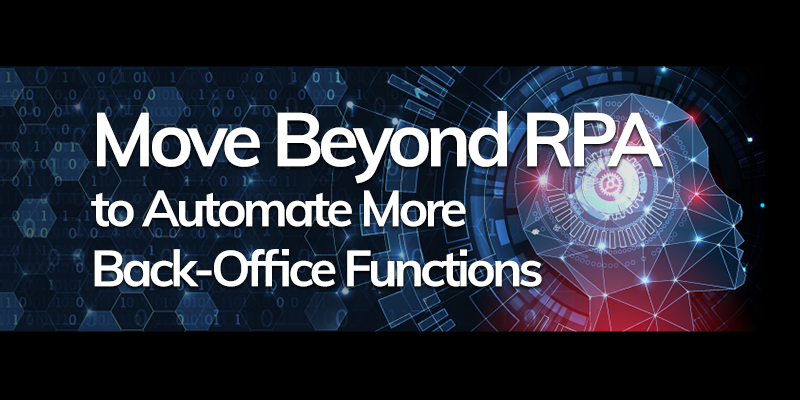Blog | AI In Finance
Move Beyond RPA to Automate More Finance Office Functions
 Robotic Process Automation (RPA) was a welcome advancement for IT and finance professionals because it easily automated routine tasks. But like many technological advances, this solution was an improvement, not a panacea. Recent advances in Artificial Intelligence (AI) address RPA’s limitations and have the potential to make processes far more efficient than RPA alone.
Robotic Process Automation (RPA) was a welcome advancement for IT and finance professionals because it easily automated routine tasks. But like many technological advances, this solution was an improvement, not a panacea. Recent advances in Artificial Intelligence (AI) address RPA’s limitations and have the potential to make processes far more efficient than RPA alone.
Finance professionals—your business office “To Do” list is long and growing daily. Check the data, update compliance rules, pay bills, and generate reports. You and your staff seem to spend your time treading water rather than advancing the business’s financial position, and initial RPA tools provided by IT are no longer checking the box.
You are not alone: most finance pros have stated that repetitive follow-ups and a lack of responsiveness are their biggest challenges. Advanced technology has the potential to change that dynamic.
First-Generation and Second-Generation Back Office Automation
RPA emerged as a first-generation solution. The preconfigured software uses business rules and predefined activities to choreograph and automate the execution of repetitive processes, transactions, and tasks involving one or more software systems. Such solutions deliver results with little to no human intervention, according to IEEE Standards Association (SA).
The technology provided a welcome level of automation across business systems. These systems are good at inputting and consolidating information entered on generic forms. This advancement was a step in the journey to streamline functions but not the endpoint.
Better tech emerged. AI has the power to combine cognitive automation, machine learning, reasoning, hypothesis generation and analysis, and natural language processing to produce insights that lead to actions automatically, according to IEEE SA.
 Explicit and Implicit Instruction
Explicit and Implicit Instruction
The two foundations operate distinctly. RPA is regimented: every activity needs to be explicitly scripted. RPA Bots must be told precisely where to extract relevant information from each document or input. Because the software lacks intelligence, it does not learn by itself. The solution is usually not smart enough to adjust if a minor item is overlooked, or change is made to the format.
Injecting advanced technology into an RPA process will exchange and expand the capabilities of RPA alone. AI systems are intelligent. They are trained with models and once implemented, no longer have to be told what steps to take. They draw deductions and make decisions themselves, and continuously improve.
Structured Data and Unstructured Data
The type of information that computer systems create and track has also morphed through the years. Initially, enterprises relied on Database Management Systems that housed textual information in tables. RPA typically relies on such structured data to execute tasks.
Data has become more freeform and unstructured with the move to images and video. AI is flexible enough to work with structured and unstructured information, handling inconsistent inputs or changes to formats.
Installation and Maintenance
Maintenance is often an ongoing challenge with software applications. With RPA, enterprises create a bespoke, unique solution suited to the business. As a result, the organization becomes responsible for ensuring that the solution runs the latest software version so any security holes have been patched. Organizations also must ensure that its connections to other applications are maintained whenever an update is released. Such work is tedious and time-consuming. Most businesses lack the skills to do that work, so they often offload it to (expensive) systems integrators.
When you rely on a SaaS-based AI solution, you offload software maintenance to your supplier / vendor. They ensure that your applications – and all integrations with other systems – are up to date. SaaS reduces the need for professional services and also speeds up the development process. In today’s unprecedentedly volatile and mercurial environment, speed and agility have become top business drivers.
RPA’s Niche
That said, RPA has many appropriate uses. Some companies still rely on legacy on-premise systems, and for those systems, RPA works well.
In comparison, AI systems address specific operational challenges. For example, Auditoria is designed for corporate finance. With this type of pre-configured and trained technology, organizations could then invest in other areas, instead of teaching the system about finance terms or how to read an invoice. Functionality such as understanding unstructured data such as email intention or an open invoice, are baked into the program.
AI and RPA are not antithetical. An AI system might complement an RPA system, especially if a purpose-built solution is the best choice for a specific department or function to streamline activities. In contrast, the RPA system may help the business by retrieving hard-to-access data from legacy systems.
What You Need in a Financial Automation Solution
But not all AI-based SaaS systems are created equally. When evaluating them, you need to look for a simple, intelligent system of engagement that:
- Is purpose-built for your needs (vendor management, audit, etc.)
- Works with your existing systems
- Inherently understands specific industry challenges
- Provides sophisticated decisions support, including cash forecasting recommendations
RPA solutions were a welcome addition to business processes several years ago. Recent advances led to the creation of smarter AI solutions that require less maintenance than RPA systems. When examining your financial automation options, look for one with deep financial depth, or if you have RPA in place, look for advanced tech that integrates with your current technology as well. With AI-enable software, you and your staff will spend more time maximizing your firm’s fiscal resources and less time completing routine or manual transactions.
To learn how Auditoria can accelerate your finance transformation, request a free demo of Auditoria SmartFlow Skills here.
